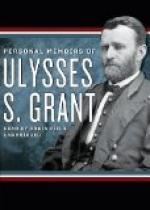Hancock immediately sent two divisions, commanded by Birney and Mott, and later two brigades, Carroll’s and Owen’s, to the support of Getty. This was timely and saved Getty. During the battle Getty and Carroll were wounded, but remained on the field. One of Birney’s most gallant brigade commanders—Alexander Hays—was killed.
I had been at West Point with Hays for three years, and had served with him through the Mexican war, a portion of the time in the same regiment. He was a most gallant officer, ready to lead his command wherever ordered. With him it was “Come, boys,” not “Go.”
Wadsworth’s division and Baxter’s brigade of the 2d division were sent to reinforce Hancock and Getty; but the density of the intervening forest was such that, there being no road to march upon, they did not get up with the head of column until night, and bivouacked where they were without getting into position.
During the afternoon Sheridan sent Gregg’s division of cavalry to Todd’s Tavern in search of Wilson. This was fortunate. He found Wilson engaged with a superior force under General Rosser, supported by infantry, and falling back before it. Together they were strong enough to turn the tables upon the enemy and themselves become aggressive. They soon drove the rebel cavalry back beyond Corbin’s Bridge.
Fighting between Hancock and Hill continued until night put a close to it. Neither side made any special progress.
After the close of the battle of the 5th of May my orders were given for the following morning. We knew Longstreet with 12,000 men was on his way to join Hill’s right, near the Brock Road, and might arrive during the night. I was anxious that the rebels should not take the initiative in the morning, and therefore ordered Hancock to make an assault at 4.30 o’clock. Meade asked to have the hour changed to six. Deferring to his wishes as far as I was willing, the order was modified and five was fixed as the hour to move.
Hancock had now fully one-half of the Army of the Potomac. Wadsworth with his division, which had arrived the night before, lay in a line perpendicular to that held by Hill, and to the right of Hancock. He was directed to move at the same time, and to attack Hill’s left.
Burnside, who was coming up with two divisions, was directed to get in between Warren and Wadsworth, and attack as soon as he could get in position to do so. Sedgwick and Warren were to make attacks in their front, to detain as many of the enemy as they could and to take advantage of any attempt to reinforce Hill from that quarter. Burnside was ordered if he should succeed in breaking the enemy’s centre, to swing around to the left and envelop the right of Lee’s army. Hancock was informed of all the movements ordered.
Burnside had three divisions, but one of them—a colored division—was sent to guard the wagon train, and he did not see it again until July.




